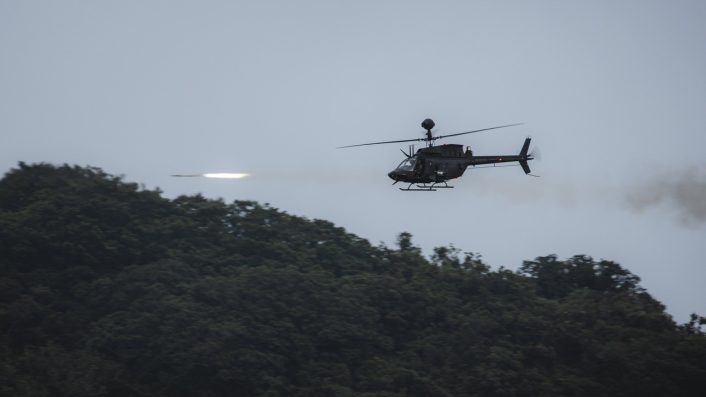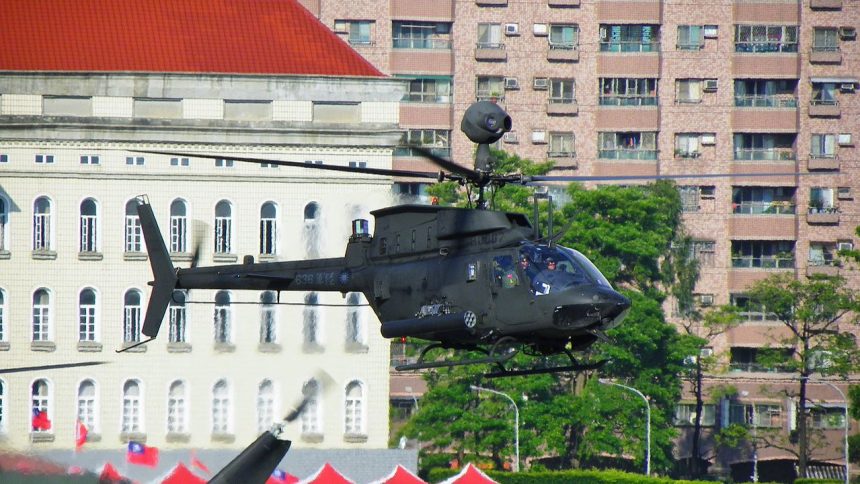The lighter OH-58D was designed to fly ahead, scout and locate targets for the heavily armed AH-64 Apache.
Taiwan’s Army Aviation and Special Forces command will celebrate on Jun. 28, 2024, its 80th anniversary and, on Jun. 25, held a preview ahead of the ceremony at a base in Tainan. The ceremony rehearsal saw multiple Taiwanese helicopters being displayed to the public and conducting drills, including the U.S.-made AH-64E Apache, AH-1W Super Cobra, UH-60M Black Hawk, CH-47 Chinook, and OH-58D Kiowa Warrior, according to Liberty Times.
On Jun. 13, the Military News Agency also showed the AH-1W, OH-58D and UH-60M participating in drills at Taiwan’s Army tri-service joint training base, dubbed “113-2 Air Weapon Live Fire”. Each helicopter employed its onboard weapons against targets in the range, without being affected by the bad weather.
The OH-58D Kiowa Warrior’s continuous presence in Taiwanese military operations warrants an examination on its usefulness, considering that the forward scout chopper was retired by the U.S. Army because of its obsolescence in the modern contested battlespace. The service, in fact, assessed it to be vulnerable to newer Russian and Chinese medium, short-range, point defense and man-portable shoulder-fired AD (Air Defense) systems.
The vulnerability was among the motivations for the FARA (Future Attack Reconnaissance Aircraft) program, whose goal was to replace the OH-58D Kiowa Warrior following its retirement in 2017. Together with FLRAA (Future Long-Range Attack Aircraft), the soon-to-be canceled FARA was part of the larger FVL (Future Vertical Lift) program.
陸軍 #航空特戰指揮部 於三軍聯訓基地進行「 #113-2空用武器實彈射擊 」,航特部所屬 #第602旅… pic.twitter.com/K17S89oBYy
— 軍聞社 Military News Agency, ROC(Taiwan)🇹🇼 (@mna_roc) June 13, 2024
Taiwan’s OH-58Ds
The OH-58D is an upgraded variant of the Vietnam-era OH-58A, which was itself a militarized variant of the Bell 206 Jet Ranger. With its distinctive mast-mounted electro-optical sight, the lighter Kiowa Warrior was meant to fly ahead, scout and locate targets for the heavily armed AH-64 Apache. The Apache was then supposed to employ its AGM-114 Hellfire missiles at long-range against Soviet tank columns.
Taiwan appears to have a similar orientation for the use of the Kiowa Warrior. The post on X by the Military News Agency, in fact, called it the “combat search helicopter.” Taiwan Air Power lists a total of 20 units of the Kiowa Warrior, assigned to the Armed Reconnaissance Helicopter Battalion in each of its two Airborne Brigades.
#陸軍 #航空特戰指揮部 「空用武器射擊」火力全開,精準命中!
–
陸軍航空特戰指揮部在恆春三軍聯訓基地進行「112-1空用武器基礎射擊」, AH-64E阿帕契攻擊直升機、OH-58D戰搜直升機、UH-60M黑鷹直升機對靶區進行射擊,展現空中、地面精準打擊戰力!#ProtectOurCountry #ROCARMY #ROC #Taiwan pic.twitter.com/oVzT13TFhr
— 軍聞社 Military News Agency, ROC(Taiwan)🇹🇼 (@mna_roc) February 17, 2023
The OH-58D can carry XM296 .50 caliber machine guns, M260 seven-tube 70 mm rocket pods and AGM-114 Hellfire air-to-ground missiles installed on a UWP (Universal Weapons Pylon) on both sides of the airframe. It’s not known if Taiwanese OH-58Ds can also employ the AIM-92 ATAS (Air-To-Air Stinger). As mentioned earlier, the helicopter is equipped with the distinctive MMS (Mast-Mounted Sight), with a smaller TV sensor, a larger FLIR (Forward-Looking Infrared) and a laser-range finder.
For survivability, the Taiwanese Kiowa Warriors feature the AN/ALQ-144 IRCM (Infrared Countermeasures), the AN/APR-39(V)1 and AN/APR-44(V)3 RWRs (Radar Warning Receivers) and the AN/AVR-2A(V)1 LDS (Laser Detecting Set). Contrary to the U.S. Army’s OH-58Ds, the Taiwanese helicopters are not equipped with the AN/AAR-57 CMWS (Common Missile Warning System) with AN/ALE-47 countermeasures’ dispensers.
What role could they play against China?
From a purely size comparison standpoint, Taiwan’s military in general would be numerically overwhelmed by the PLA Navy, PLA Air Force and the People’s Liberation Army in the event of a Chinese invasion.
Taiwan’s AH-64 Apaches will play a massive role in stopping advancing columns of Chinese ZBD05 and ZLT05 amphibious assault vehicles during amphibious beach landings, before they get a chance to head inland. Taiwan has also been practicing beach defense drills with both anti-infantry and short-range AD elements.

Once China’s amphibious Type 075 LHDs (Landing Helicopter Docks) are ready and fully operational, they are likely to release waves of Z-10 attack helicopters, and possibly the new Z-21 heavy helicopter gunship. This would be in addition to a massive artillery, cruise missile and tactical ballistic missile barrage landing on all of Taiwan’s forward military and support bases around the island.
Taiwan has also indicated adopting its ODC (Overall Defense Concept) by introducing small unmanned boats for both kamikaze and surveillance roles, besides launching a massive drone development program. Thus, if the overall goal is to successfully resist the Chinese in a multi-layered campaign of attrition long enough for U.S. and Allied help to arrive, the OH-58Ds might not be that outmoded.
If Taiwan’s political and military leadership decides not to give into the pressure or reject the fait accompli that the PRC aims to present, the OH-58D does offer options to prolong the urban and anti-armor war by nimbly flying around the mountains in the east and harassing Chinese troops and tanks. With the key words being “prolong” and “harass,” Taiwanese forces in the medium-long term might be vulnerable to PLA’s detection after it has established air superiority and continuous aerial surveillance.
In other words, the deciding factor would eventually be political. That is, whether the leadership in Taipei and Beijing decide to escalate – and risk a high-casualty urban war with political consequences for both – and Washington guarantees a military intervention in support of the former, sparking a regional war that might devastate the entire east Asia.









